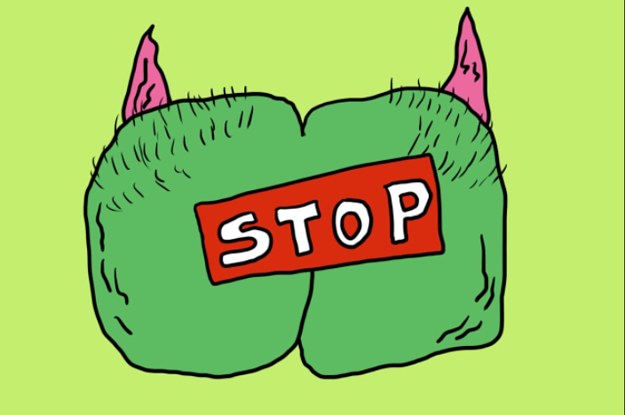All my goblin asses are gone.
BuzzFeed News Reporter
A Goblin Ass, part of a collection of 8,888 unique NFTs of, uh, butts of goblins.
Late last night, Fedor Linnik discovered that any crypto enthusiast’s nightmare had become his reality. The NFT collection he was planning to launch — 8,888 unique Goblin Asses — had been hijacked.
Just as Linnik and his friends were planning to launch Goblinass.town, they discovered a scammer had copied their thousands of cartoons of goblin butts and posted them as their own collection on OpenSea. The heist was first reported by the blog Web3 Is Going Great.
Why goblin asses? Well, see, the NFTs were inspired by the surprisingly successful collection Goblintown. The anonymous founders of Goblintown pretend to actually be goblins, writing and speaking in a sort of weird goblin-talk, which led to one of the greatest Twitter Spaces of all time (please listen with the sound on):
Bruhhhh 💀☠️ this space is too much Lmao #goblintown (volume up)
Goblintown, against all odds, has become incredibly lucrative, with a current floor price of around $10,000. It’s cute, it’s funny, it’s cheeky; it’s an elaborate in-joke poking fun at the self-serious NFT world (the goblins often refer to “Gary Pee” instead of Gary Vee). It’s riding the zeitgeist of goblincore and “going goblin mode.” There’s a whole slew of knockoffs, like Goblin Pride, FatGremlin, Gremlinville, OrcVillage, and the Shrek-themed Ogretown.
Ja Rule, a noted enthusiast of all things totally above board, owns a Goblin.
Where my Goblins at??? Check out this item on OpenSea https://t.co/xP7ljK5khA via @opensea
Linnik, 26, has been involved in crypto and NFTs since 2017, and appreciated the layers of irony with Goblintown. He teamed up with artist Vitaly Terletsky, who drew the butts, and two other friends.
“I’d been showing Vitaly all the ugly Goblintown free mint derivatives which were already popping up getting clout and high volumes,” Linnik told BuzzFeed News. “He said, ‘Damn it! I can do the same!’ and drew the ass collection overnight.” And so, Goblin Asses was born.
They quickly made a website and a Twitter for the collection and put it up on a testing version of OpenSea, where they could make sure it worked before officially launching. “We turned it into a little challenge to make a collection from idea to deploy in three days,” Linnik said.
Then, last night they realized that someone else had stolen their art and posted it. Linnick told BuzzFeed News that he’s not totally sure how the scammer did it, but he suspects two possibilities. One is that someone found their semi-public website, which had some of the images and metadata already up. The other possibility is that the collection could have been stolen through the testing version of the OpenSea site — many people use the testing site, which is publicly viewable, to make sure their collections are displayed and set up correctly before officially launching.
However, most people only post a small sample of their collection on the test site. In his haste, Linnik posted the whole Goblin Ass collection, leaving it vulnerable. “We just didn’t think there would be bad actors caring about a free mint collection with 170 people on Twitter like ours,” Linnik told BuzzFeed News.
@nikitaa_nk @vitalyterletsky Here is me and @vitalyterletsky saving our asses in an rented apartment of a Turkish family we know nothing about. What a day!
Art theft is rampant on OpenSea, and a real headache for artists, but it usually takes a different form: a person (or bot) uploads an image of the art and sells it as an NFT. OpenSea created a “lazyminting” tool, which made it incredibly easy and free to mint big collections, and scammers took advantage of with stolen art, often scraped from the website DeviantArt by bots. In January 2022, OpenSea announced it would limit the use of the lazyminting tool, partially because the company discovered that 80% of all NFTs that it had to remove for violations, including copyright infringement, were made with the lazyminting tool.
To combat some of this OpenSea has created new tools to try and prevent copycat NFT collections, including its own image recognition tools and human moderators. “Our policies prohibit plagiarism, which we regularly enforce in various ways, including delisting and in some instances, banning accounts,” Allie Mack, a spokesperson for OpenSea told BuzzFeed News. “We recently launched image recognition technology as part of our larger efforts to rapidly build the tech, teams, partnerships and processes to more quickly and effectively enforce against this issue. For copies of content that are not already on OpenSea, users can submit a DMCA request and we will quickly remove the identified items from our site.”
Linnik noted that the scammer had actually lost money on the project, since they had to pay some upfront costs to launch it, and hopefully it will get shut down by OpenSea. He said the Goblin Asses team has filed a content report but, but since they hadn’t officially copyrighted the goblin ass drawings, they didn’t try to do a DCMA request. They haven’t heard back yet on their report.
You can’t keep a nonfungible Goblin Ass down, though. The team has gone ahead and officially launched the REAL collection — this time with a little holographic sticker in the top corner, specifying each JPG has what Linnik calls a “certificate of ass-enticity.”
Correction: Eighty percent of the NFTs removed for violations were made with the lazyminting tool, OpenSea said. An earlier version of this post misrepresented this percentage.
This post has been updated with a comment from OpenSea.
Katie Notopoulos is a senior technology reporter for BuzzFeed News and is based in New York. Contact this reporter at katie@buzzfeed.com.
Contact Katie Notopoulos at katie@buzzfeed.com.
Got a confidential tip? Submit it here

